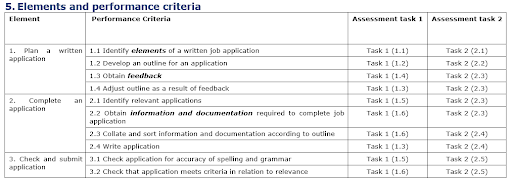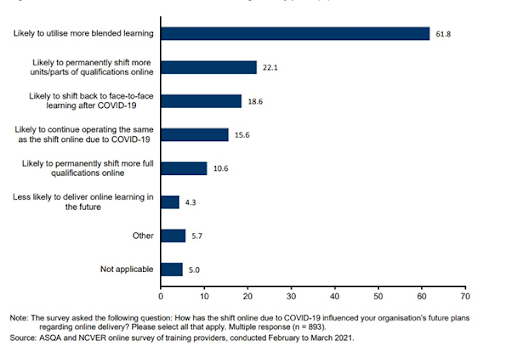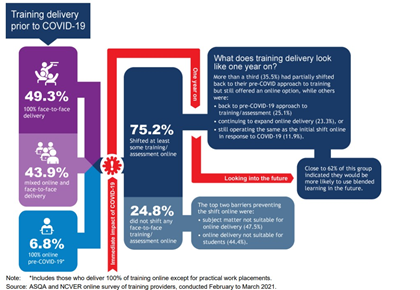Understanding contextualisation
Contextualising assessments and learner materials is one of the most thought-provoking tasks that RTOs face. Many RTOs are deemed non-compliant due to their contextualisation ‘methods’.
What is contextualisation, what is the right way to do it, how is it done, why do RTOs conduct it incorrectly?
Before explaining what is contextualisation, let’s first clarify what is NOT contextualisation as that is one of the main reasons RTOs face enormous challenges.
What is not contextualisation?
Contextualisation is not a free ride process to change at whim the training product requirements specified in the relevant training package. Contextualisation is not a green light to cross compliance boundaries and jeopardise the quality of Australian education. Contextualisation is not an exercise that focuses only on the assessment tool. Contextualisation is not a process that can be done without limits set by guidelines.
A competency’s breadth of application should not be reduced in order to reduce its portability, nor should the competency outcomes be narrowed in order to limit its use, nor should the content of any element and performance criteria related to the unit involved be removed as a result of contextualisation.
Now, to the definition:
What is contextualisation in the context of training resources?
Contextualisation is the process of modifying your RTO’s training and assessment materials to make learning more meaningful for your students and their employers, and the industry at large. It is a way of making learning and assessing relevant to a person’s workplace experience. It involves adjusting the training products such as units of competency, or packaging certain units into a qualification, to suit the specific needs of the enterprise or learner.
Generic resources that you have purchased from an RTO resources provider should be changed or adapted to satisfy the special requirements of a specific industry, as well as the social, cultural, and business requirements of that industry, as well as the needs of a particular work environment as applicable.
For example, the assessment and learner resources should be modified to suit learners from different industries without compromising the quality of the resources. That means, the training and assessment resources for a unit of competency that you use in the community sector will be different in terms of type of work performed, type of industry or enterprise, terminology used, industry sector requirements, legislation and regulations compared to resources for information technology sector.
When it comes to assessments, it is the process of adapting language and assessment tasks (terminology, assessment context and scope etc.) in order to suit specific work circumstances present in an actual workplace that is referred to as contextualisation in the context of assessments. Candidates and employers will benefit from this adjustment because the assessment resources will be more relevant and beneficial to them. For learner resources, wording, industry regulations etc. should be customised to ensure learners understand terminology and expectations to effectively work in the industry.
Contextualisation must take into account organisational policies, standard operating procedures, workplace architecture, as well as organisational and legal requirements particular to the local context in order to be compliant with Training Package regulations. It is necessary for the assessments to be considered valid in order for it to not have a negative impact on the standards specified in either the units of competency or the Training Package.
Why is contextualisation important?
Contextualisation is critical to ensure high-quality training and assessment and graduate students who are well equipped for employment or further study. It plays a significant role to enhance the qualifications. It also plays a vital role in preparing students with credible certification as holding the skills and competencies specified in their qualification when they enter the job market.
Contextualisation is essential for RTOs to develop learning resources and assessment methods tailored to their learner’s needs and aligned to the work context in which they operate. If you don’t contextualise your resources, you risk alienating your learners, losing clients and being found non-compliant at your next ASQA audit.
What is the best starting point to conduct contextualisation?
The best starting point of contextualisation of resources is to understand why you are doing it and specify your ultimate goal. The second point of departure is to be aware of the ‘rules of don’t’ regarding contextualisation.
This must be followed by identifying who would be included in the panel that is responsible for contextualising assessments. In the process of selecting your team, you are required to be inclusive, especially the industry experts who can see areas that your trainers and assessors (even with industry currency) cannot see as adequately and authentically as the subject matter experts could.
When is the best time to contextualise your resources?
The best time to conduct your contextualisation is today. To ensure quality training is delivered on time and any content that does not align with the cohort’s requirement is captured and rectified at the earliest stage, the best practice is to contextualise as soon as possible and as finest as possible.
Timely contextualisation will help you to ensure:
- High quality and better outcomes for your students, hence better reputation for your RTO
- Better relationship and engagement with the industry
- Continuous improvement that provides assessment system and practice is performing at their best
- Conduct routine improvement activities
- Introduce a more efficient and effective process and system that monitors your practice
- Early intervention to check any gap and early rectification to fill the gap before affecting future students
What learning resources are included in the process of contextualisation?
One of the mistakes that surface repetitively in the RTOs landscape is the practice of contextualising focus on assessment tools only. This leaves students dealing with different resources that do not talk to each other, and at times provide inappropriate or conflicting content.
So, as a minimum requirement, RTOs must contextualise the following resources;
- Training and Assessment Strategy
- Assessment tools including RPL kits
- Learner Guide
- PowerPoint
- Session and delivery plan
- Facilities and equipments
- Self study guides and manuals
- Workplace logbooks/vocational placement kits
- Facilitate delivery and assessment of learners
What are the factors that can influence your contextualisation process?
For a comprehensive understanding and best experience, we advise you to consult with industry experts, check your current status, and make a situational analysis.
As a general principle of contextualisation, the following questions must be raised and appropriately addressed before embarking on the process of Contextualisation.
1. Learners.
The characteristics of the target group. The study should include information about the knowledge and skill, learning needs, learning style preferences, literacy, language and numeracy skills, and support needs.
This section can also include the learners’ level of motivation for engaging in the learning, any specific goals of the group, and any particular abilities that the group may have.
2. Mode of Delivery
This study must focus on how the training and assessment are to be delivered. This might include face-to-face, online, through workplace training or a mixture of different modes. The information provided in this section should be consistent with and supportive of the information in the remainder of the TAS document. For example, if your delivery is online, but the assessment tool has workplace tasks, your Contexualisation must consider how to provide a virtual simulated workplace environment to ensure they can practice their new skills.
3. Workplace and Industry.
This section must analyse what does the workplace environment look like? (e.g., equipment, facilities, policies, procedures, etc.)
- What types of evidence can be collected in the work role to meet the unit of competency evidence requirements? What are the typical tasks performed in the work role and industry context?
- What are the typical and current workplace conditions for the work role and industry context?
- What is the relevant legislation, codes of practices, and regulations for the work role and industry context?
4. The Resources
This section will probe what specific resources are required to deliver and assess the Training Product. This might include an assessment, a session plan, or a detailed list of resources for a unit of competency or cluster of units. This may also include information about the resources the learner might be required to provide or have access to. An example would be if the delivery were online, there would be a requirement to access a computer and potentially stable internet connection. You can address the requirements by raising valid question such as:
- Do the learning resources provide enough depth in the instruction, including industry-relevant practical examples, to meet the needs of learners with little or no previous experience?
- Is the learning content appropriate for learners with physical and learning disabilities, language, and cultural sensitivities?
- Is the learning resource content aligned to the industry context, work role tasks, and work environment? Examples also include access to:
- Job role and workplace relevant policies and procedures
- Workplace appropriate equipment and facilities etc.
- Work role and workplace relevant conditions and environment.
- Actual workplace or Simulated Workplace (were allowed in the training package)
- Do the learning resources align with the qualification and/or training package context where it is being used?
- Do your learning resources align with your Training and Assessment Strategy and Delivery Method?
In line with the COVID related requirements and the online delivery necessitated by it, please see also ASQA’s distance learning guide by clicking this link. https://www.asqa.gov.au/distance-learning
5. Training in the Workplace
- What are the training and assessments that must be conducted in the workplace?
- Do they align the learning activities with the organisation’s objectives and overall culture?
- Do they contain activities and tasks that are relevant and are users of the business itself?
- Are the learners’ tasks valuable to all parties? Are the activities advantageous to provide opportunities for students to learn problem-solving skills?
- Are there workplace mentor-mentee scenarios that may also be suitable for this training delivery method?
How does contextualisation ensure candidates can apply their skills and knowledge in a work setting.
The primary objective of contextualisation is to make the training and assessment strategy more meaningful for your students and their employers. RTOs need to develop learning resources and assessment methods that are custom-made to their learner’s needs and aligned to the work context in which they operate.
Contextualising ensures best practice and high-quality training and assessment strategy and practice. In turn, high-quality training and assessment mean that employers can have confidence that vocational education and training (VET) graduates in the workplace will safely and productively apply the skills described by their qualifications.
Does contextualisation serve the principle of assessment and rule of evidence?
Contextualisation is mainly conducted to accommodate the learners’ needs and ensure the content is adjusted to be appropriate to the learner cohort’s skill, knowledge and experience levels. Accordingly, the task of contextualisation must primarily serve the principle of fairness framed on the individual learner’s needs and the principle of flexibility underpinned by the reflection of the individual learner’s circumstance.
To promote fairness and flexibility contextualisation must start from the below questions.
- Can the assessment gather Valid, Sufficient, Authentic, Current evidence.
- Is the assessment appropriate for the target audience/ or client group for whom the use of the training and assessment resources will be relevant?
- Does the assessment contain a range of different assessment methods: Knowledge assessment: Workplace projects – advanced practice, Projects – analysis, design and development
- Does the assessment tool provide enough depth in the instruction, including industry-relevant practical examples, to meet the needs of learners with little or no previous experience?
- Is the assessment content appropriate for learners with physical and learning disabilities, language, and cultural sensitivities.
- Does the assessment consider the work performed and the environment in which it would be completed. Do the tasks suit particular work conditions that apply in an actual workplace?
- Does the assessment include policies, standard procedures, workplace infrastructure and organisational and regulatory requirements of the local context
If candidates/learners/students are of high importance in the process of contextualisation, what do you need to consider about them?
There are several questions that you might want to ask, including:
- What are the likely characteristics of the learner group?
- What would look like their work environment, industry, and work role when they graduated.
- What level is their existing skills and knowledge? Do they have RPL/Credit?
- Are they self-motivated?
- Can learners complete group activities?
- Do they need to be adapted to suit individual learners?
- How much time will they have to complete tasks?
- What will their access to resources, facilities and equipment be like?
Is there any manual that guides how contextualisation must be conducted?
There is no prescribed and strict manual that can fit all sizes. Each contextualisation’s objective, qualification, learning outcome or cohorts’ need has its own peculiarity; hence contextualisation is adapted accordingly.
However, there is a general guide that can help your contextualisation process.
Let’s start with the legislative guidelines.
The National Skills Standards Council (NSSC) identified three steps involved in contextualising assessment resources:
- Clarify the assessment context.
- Review and contextualise the assessment resources.
- Trial the Contextualised assessment resources.
The Standards for RTO 2015 Clause 1.8 to 1.12 stipulates:
“When developing assessment materials, use the information from the unit or module elements, performance criteria and assessment requirements to determine what competence looks like. Ensure that assessment tools are contextualised (or can be contextualised) to the student cohort to produce valid skills that are relevant to the student’s industry or work context.”
In addition to these two guidelines, the below best practices are helpful to conduct effective Contextualisation:
Phase 1: Understand what you are required to do
This includes conducting thorough research of the legislative requirements and guidelines, knowing your boundaries and the areas that should not be compromised in the process of Contextualisation.
Phase 2: Unpack the training and assessment resources
Unpacking the resources, including all documents related to the qualification, is a good sequence during your Contextualisation process. This must incorporate the industry requirements, the work placement time, the mode of delivery, the duration etc.
All the resources and assessment will be studied in relation to the cohort and their requirements. As repeatedly noted, the central objective of contextualisation is to ensure the learning resources are appropriate to the cohort’s needs.
Phase 3: Review your training and assessment resources.
When reviewing your training resources, make sure that you make the principle of assessments and rule of evidence your road map. Assessment resources should be identified or developed and reviewed to determine their appropriateness for the context.
In this stage, one of the ‘must-dos’ is to ensure the context-specific criteria can be substituted or added to complement the requirements in the resources and associated units of competence. You must check if the learning resource content is aligned to the industry context.
You must ascertain the assessment tools and guidance materials that can include organisation-focused performance checklists, question banks and sample responses, case study materials, assessment projects, reference documents, job cards.
Note: Please always remember that your contextualisation must not jeoperdise the learning outcome. You are not allowed to remove anything from the elements and performance criteria, distort or limit the competency outcomes and use, and reduce the breadth of application of the competency and lessen its portability.
Phase 4. Trial before implementation
The trial of the contextualised assessment resources, associated strategies, assessment tools and related guidance materials is best practice to avoid any unseen potential problems.
The trial will help you identify and monitor the status/success of your contextualised resources and improvement opportunities and initiate any required quality improvements.
In addition to the trial, a risk management matrix for the contextualised assessment strategy should be prepared. This includes.
- A listing of the Principles of Assessment and Rules of Evidence
- The potential risks to the achievement of these quality criteria
- The risk management measures embedded in the assessment strategy to overcome or minimise these risks
Phase 5: Recording: remember to record all the changes and update the version control. You must make sure you record any changes you make to present them at audit as evidence.
How can contextualisation be explained using an actual method and example?
Contextualisation is a process that is not necessarily guided by a uniformed method; however, whatever practices the RTO engages, the above points must be taken into account.
Start with this: The central theme of any contextualisation is to design/redesign the learning and the assessment strategies and practices to meet the learners’ needs and make the learning relevant to a person’s workplace experience – current or anticipated.
More importantly, RTOs are required to know what should/could not be done in the name of contextualisation.
The below example is one way of conducting your contextualisation correctly.
Sometimes you will find units that are shared by two or more qualifications. Even though the unit’s code and name are the same, the context and industry requirements are different. For example, CHCDIV001 – Work with diverse people is shared by Early Childhood, Individual Support, Nursing, Audiometry, Ambulance Communications (Dispatch), and Animal Care and Management etc. However, it is applied in different contexts, tasks, assessment conditions and simulated environments.
For the sake of our article, let’s look at ECEC, Nursing and Individual Support (all share CHCDIV001).
If we take one Element, for example, Element 3: ‘Communicate with people from diverse backgrounds and situations and PC: 3.1 Show respect for diversity in communication with all people, concerning a) ECEC, b) Individual Support and c) Nursing the task, the work environment, and job role are entirely different. Accordingly, the context, the tasks, the marking guide, condition of assessment, work placement simulation, the resources required must be contextualised in the context of the workplace and simulated role-play.
| CHC50113 – Diploma of Early Childhood Education and Care
CHCDIV001 – Work with diverse people |
HLT54121 – Diploma of Nursing
CHCDIV001 – Work with diverse people |
CHC33015 – Certificate III in Individual Support
CHCDIV001 – Work with diverse people |
| Role Play
Ms. Annu, a Malaysian mother who cannot speak English, came to the Child Care Centre to discuss her daughter’s allergies.
Simulation:
Regulated Child CareHuman resource: Interpreter |
Role Play
Mr. Ahmed, a Muslim patient in hospital who can barely speak English, is agitated because he was not provided a place to pray.
Simulation: Hospital
Human resource: Cultural interpreter, patients room |
Role Play
Christine, a ‘transgender’ person, fluent in English, who lives in a residential care, is outraged because the fellow residents attacked her with a series of derogatory comments.
Simulation: Regulated Aged Care
Human resource: Social worker |
| The Element is ‘Communicate with people from diverse backgrounds and situations and PC: 3.1 Show respect for diversity in communication with all people.
As can be seen below, the Element above is the same; however, the industry and context of the role play are different; hence you cannot use one of them in the three role-play scenarios; thus, Contextualisation is required. |
| Observation Checklist |
| Did the student demonstrates the following communication skills |
Did, the student, demonstrate the following communication skills |
Did, the student, demonstrate the following communication skills |
- Speak through an interpreter.
- Clarify information with the interpreter and request that they give an accurate translation
- Request that the interpreter inform you of any potential communication differences that could arise (to be self-aware)
- Give the interpreter time to restructure the translation in their mind (to be socially-aware)
- Patiently wait for a response via the interpreter, regarding Mr Wong’s feelings about the task
- When the interpreter is translating, maintain non-verbal communication directly with Ms Annu to provide her a sense of trust and comfort.
|
- Greet Ahmed respectfully (to be socially-aware) and patiently wait for a response
- Use short and simple sentences.
- Use different words to express the same idea
- Clearly state you respect his practice and will assist him in providing him prayer place (to be socially-aware)
- Ask Ahmed if there are any other religious requirements that you should be aware of (to be socially-aware)
- Resolve communication differences by using cultural interpretation:
- Politely ask Ahmed to repeat what he said for clarification
- Ask Ahmed how he is feeling now that the issue is resolved.
|
- Ask Christine what their preferred gender pronoun is (e.g., she, he, they) (to be socially-aware)
- Clearly state you respect the gender preference
- Avoid the words’ real man’ ‘real woman’ or transgender
- Remember to keep the focus on care rather than indulging in questions about their gender of curiosity
- Display transgender-positive body language and nonverbal communication and cues in your office.
- Avoid ‘dead naming; do not use the former name.
|
Call us on 1800 266 160 or email info@caqa.com.au to find out more. Let us bring CAQAs Validation professional team to you – don’t wait until your next audit is due.






















